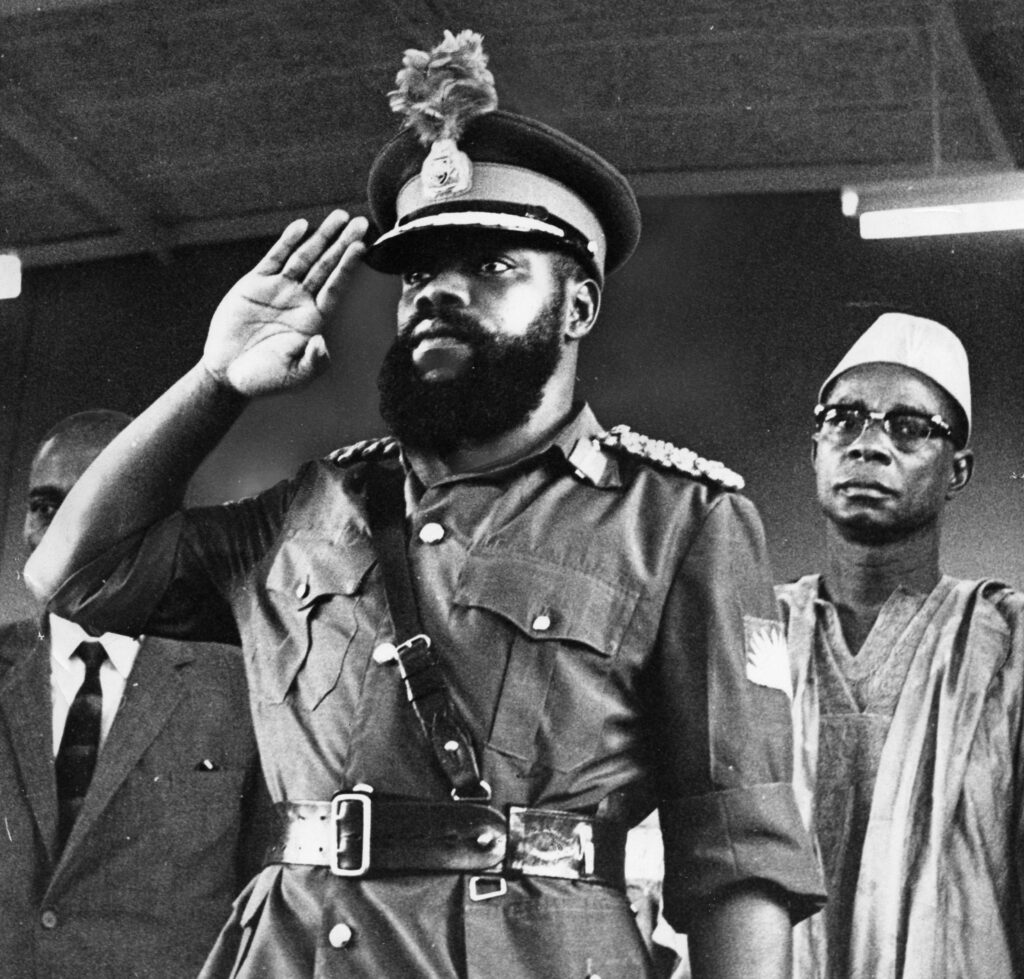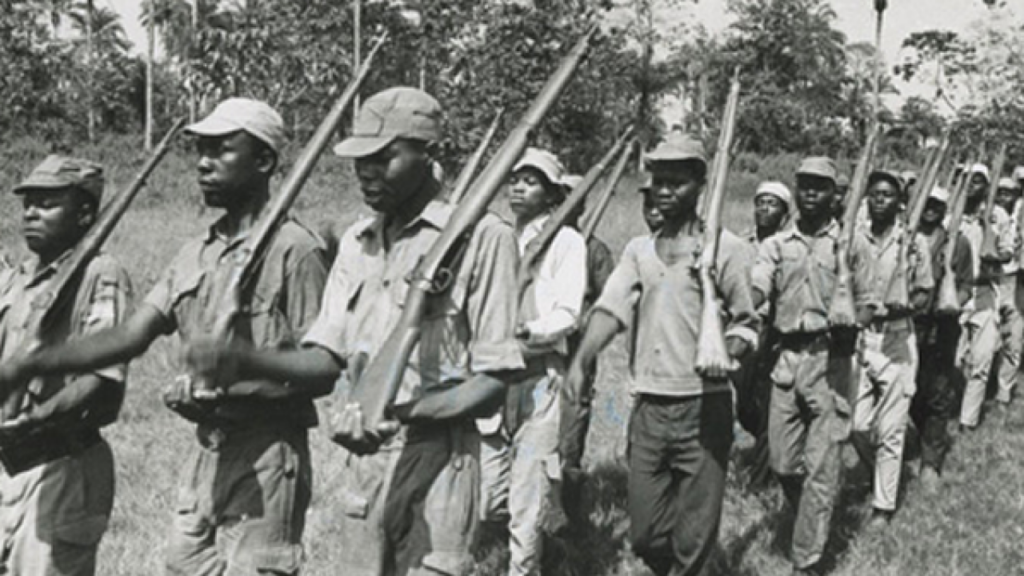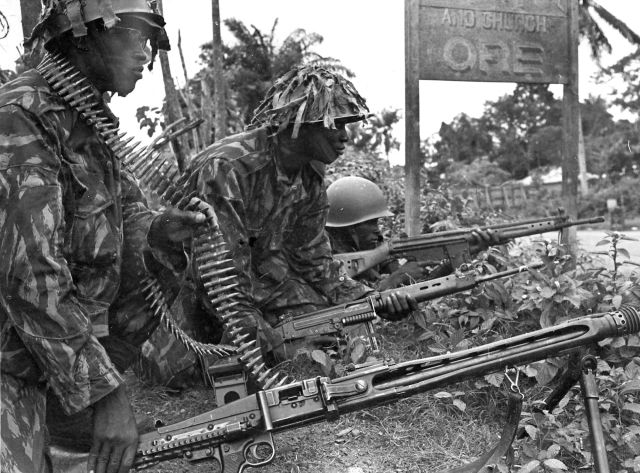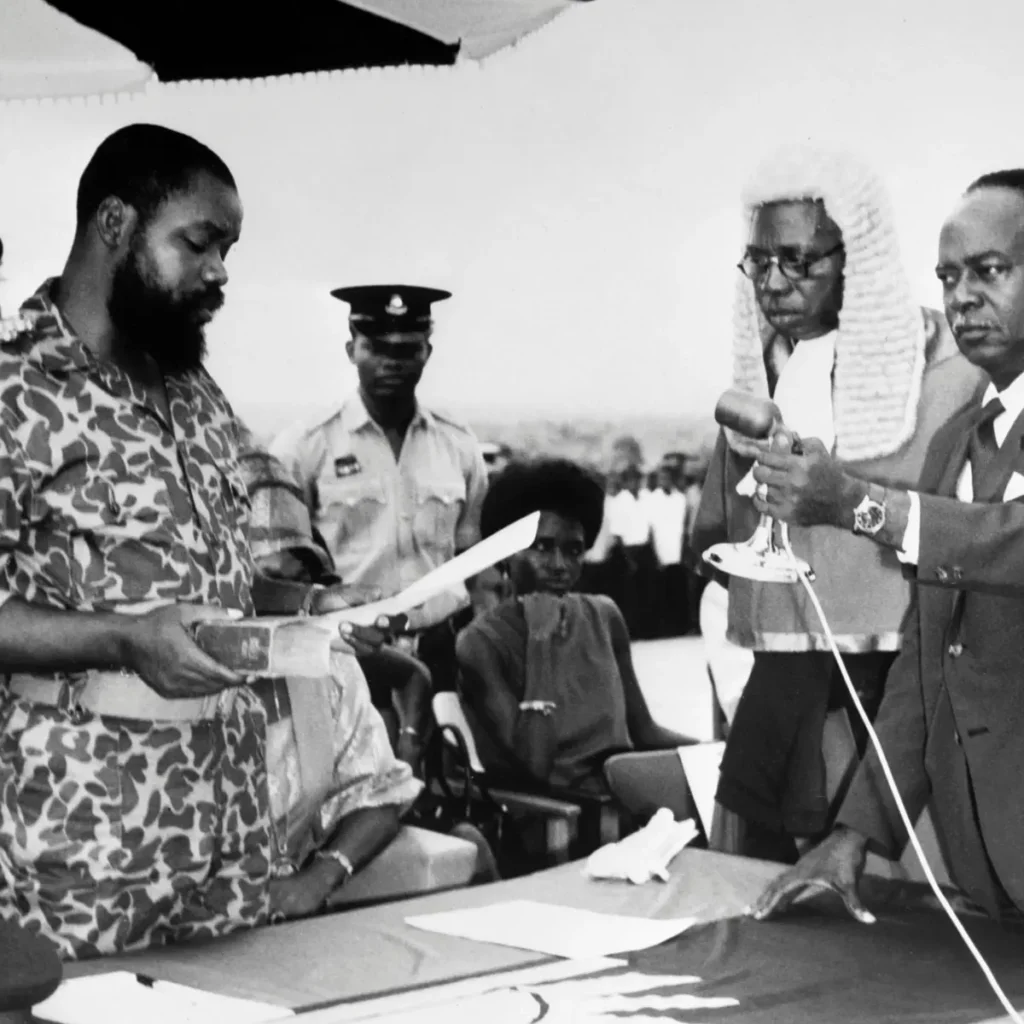The battle over the breakaway state of Biafra is widely viewed as a sad occurrence best forgotten by most Nigerians, yet it remains a life-defining event for the Igbo people who fought for secession. The events that preceded the creation of the Republic of Biafra were summarized by the Igbo people as the suffering that existed throughout the years the military ruled, suppressing the Igbos. According to history, Biafra was created because of the power concentrated in the hands of the northern rulers.
In this piece, Naijabiography explored the story behind the creation of the Republic of Biafra and the Biafra War.
History
Following a series of ethnic tensions following Nigeria’s independence in 1960, which culminated in the 1966 massacres of Igbo people and other southeastern ethnic groups living in northern Nigeria, Biafra was established on May 30, 1967, by Igbo military officer C. Odumegwu Ojukwu under his leadership. From 1967 to 1970, the Republic of Biafra was a partially recognized secessionist state in West Africa that declared independence from Nigeria. Its area included Nigeria’s primarily Igbo-populated Eastern Region.
Nigeria obtained independence from the United Kingdom in 1960. Six years later, Muslim Hausas in northern Nigeria began slaughtering Christian Igbos in the region, forcing tens of thousands of Igbos to escape to the east, where their ethnic group was the majority.

Because the Igbos feared that Nigeria’s authoritarian military administration would prevent them from developing or even surviving, Lieutenant Colonel Odumegwu Ojukwu and other non-Igbo delegates in the area founded the Republic of Biafra on May 30, 1967, which included several Nigerian states.
History has it that Gabon, Haiti, Ivory Coast, Tanzania, Ethiopia, and Zambia have all publicly recognized Biafra. France, Spain, Portugal, Norway, Rhodesia, South Africa, and the Vatican City were among the countries that did not recognize Biafra but offered support and help. Non-state actors helped Biafra, including Joint Church Aid, foreign mercenaries, the Holy Ghost Fathers of Ireland, Caritas International, and the United States Catholic Relief Services. In response to the suffering, Médecins Sans Frontières was founded.
Following a two-and-a-half-year war in which nearly two million Biafran civilians, especially women and children, died of starvation as a result of the Nigerian government’s total blockade of the region. However, Biafran forces surrendered to the Nigerian Federal Military Government under the Nigerian motto of “No-Victor, No-Vanquished.” Major General Philip Effiong, the Republic of Biafra’s Vice President and Chief of General Staff, orchestrated the surrender after the original President, Colonel Chukwuemeka Odumegwu Ojukwu, escaped to the Ivory Coast.
Why the Republic of Biafra?
Nigeria gained independence from the United Kingdom in 1960. The country’s borders, like those of many other new African governments, did not reflect previous ethnic, cultural, religious, or political boundaries. As a result, the northern section of the country, which is mostly made up of the land of the indigenous Sokoto Caliphate, has a Muslim majority. The population in the south is predominantly Christian, owing to the presence of indigenous Yoruba and Igbo states in the west and east, respectively. Nigeria was divided mostly along ethnic lines after independence, with Hausa and Fulani majorities in the north, Yoruba majorities in the west, and Igbo majorities in the east.
Ethnic tensions had been simmering in Nigeria during independence talks, but ethnic and religious riots began to break out in the mid-twentieth century. In Jos, Nigeria, in 1945, an ethnic riot erupted in which Hausa-Fulani people attacked Igbos, killing and injuring many. To restore order, Kaduna police and army units had to be sent in.

The Jos violence claimed the lives of more than 300 Igbo people. Also, a similar riot occurred in Kano in 1953. And a decade later, in 1964, during the Western political crisis, Ladoke Akintola clashed with Obafemi Awolowo, dividing the Western Region. The election’s credibility was tainted by widespread claims of fraud. History has it that Westerners were particularly enraged by the Northern People’s Congress’s political dominance, as many of its candidates went unchallenged in the election. Eventually, the violence expanded across the country, some people fled to the north and west, some to Dahomey.
The North’s apparent control of the political system, as well as the widespread turmoil, prompted military leaders to consider taking decisive action. The federal government, which is dominated by Northern Nigeria, permitted the crisis to develop in order to declare a state of emergency and impose martial law in the Western Region. The situation reached a critical juncture in January 1966. A mixed but mostly Igbo group of army officers assassinated 30 political heavyweights, including Nigeria’s Prime Minister, Sir Abubakar Tafawa Balewa, and the Northern Premier, Sir Ahmadu Bello. Four of the most senior officers from the North were assassinated as well, including Sir Abubakar Tafawa Balewa, who was Nigeria’s Prime Minister, and the Northern premier, Sir Ahmadu Bello.
Later, in July 1966, General Aguiyi Ironsi and many other southern commanders were killed in a counter-coup conducted by northern officers and army forces. General Yakubu Gowon, a member of a minority ethnic group called “the Angas” in central Nigeria, was named as the head of the Federal Military government by its largely Muslim officers. Nigeria’s ethnic tensions were exacerbated by the two coups. About 30,000 Igbo citizens were massacred in the north in September 1966, while some northerners were killed in retaliation in eastern cities.
In Aburi, Ghana, in January 1967, military chiefs Yakubu Gowon and Chukwuemeka Ojukwu met with senior police officers from each zone and agreed on a less centralized union of regions. The Northerners were opposed to the Aburi Accords; however, Obafemi Awolowo, the Western Region’s leader, warned that if the Eastern Region seceded, so would the Western Region, which persuaded the northerners.
After returning to Nigeria, the federal government unilaterally declared the creation of many new states, some of which gerrymandered the Igbos in Biafra. After meetings with community leaders across the Eastern Region, the Ojukwu declared their independence from Nigeria on May 26. Four days later, Ojukwu unilaterally declared the Republic of Biafra independent, citing the Igbos killed in the post-coup bloodshed as justification.

The Biafran War
On July 6, 1967, the Federal Military Government launched an attack on Biafra. After Nigeria’s early efforts failed, the Biafrans launched their own offensive and expansion operations in August 1967, capturing territories in the mid-Western region. Nigeria, on the other hand, was able to change the tide of the war with the help of the British, American, and Russian governments. After fierce combat, the Federal Military Government reclaimed the territory in October 1967. The federal army prepared the “final offensive” in September 1968, according to Gowon. The final onslaught was initially thwarted by Biafran forces. A Southern Federal Military Government onslaught broke through the stiff opposition in the final stages.
At the start of the war, Biafra had 3,000 men, but by the end of it, it had grown to 30,000. Although throughout the conflict, there was no official help for the Biafran Army from any other country, armaments were secretly procured. Due to a lack of government support, the Biafrans built much of their weaponry on their own. Both Rolf Steiner, a German-born lieutenant colonel attached to the 4th Commando Brigade, and Welshman Taffy Williams, a Major till the end of the fight, were both Europeans who served in the Biafran cause.
Sometime in July of 1967, Biafran troops were initially successful, but federal forces with a numerical advantage began to push Biafra’s borders inward from the south, west, and north. During the war, Biafra shrank to a tenth of its previous size. By 1968, it had lost its seaports and had become landlocked, relying solely on air transport for supplies.
The Vatican, the Organization of African Unity, and others attempted to bring the combatants together. The United Kingdom and the Soviet Union continued to acknowledge Gowon’s administration as the government of Nigeria, and they continued to supply it with armaments. International concern for the plight of starving Biafran children, on the other hand, resulted in airlifts of food and medication from a variety of countries. Biafra was recognized as an independent state by Côte d’Ivoire, Gabon, Tanzania, and Zambia, while France donated weaponry to Biafra.

How did Biafran End?
After the war, the state lost its main source of money, the oil fields, and without the funds to import food, an estimated one million residents perished of severe hunger.
In a series of engagements in late December 1969 and early January 1970, Biafran forces were finally routed. After many consultations and formal activities to resolve the conflicts, Nigerian soldiers conquered Owerri, the provincial capital and one of the final Biafran strongholds, and on January 11, 1970, they forced Ojukwu to flee to the Ivory Coast. Then, on the verge of a major meltdown, Biafra surrendered to Nigeria four days later.
History also has it that Major General Philip Effiong, the Biafran Vice President and Chief of General Staff, who assumed leadership of the Republic of Biafra after Ojukwu fled to the Ivory Coast, assisted in the surrender.






Comments
Terr
2 years agoIt was a very sad time. Jamaicans were supportive of Biafra.